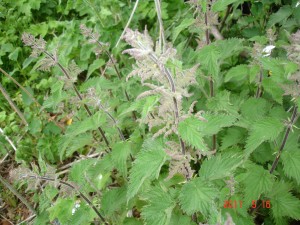Stinging Nettle
Latin: Urtica dioica
Irish: Neanntóg
The Stinging Nettle is a dark green native perennial that grows to a height of 60-100cm and has oval, pointed, strongly toothed leaves that are covered with stinging hairs, as is the stem. In June numerous, small, greenish or brownish flowers are produced in dense axillary inflorescences.
These hairs on the leaves and stems act like hypodermic needles that inject histamine and other chemicals that produce a stinging sensation when contacted by humans or other animals. Anyone experiencing this sensation and the raised, itchy weals on the skin can appreciate why “urticaria” is the medical term to describe hives.
Nettles with its habit of growing near ruins and deserted places is regarded as a symbol of desolation and abandonment but they have also been highly regarded for several uses and benefits. Nettle fibres were used inIrelandduring the Bronze Age to make fine, strong cloth and the juice was used as a green dye. It was also an important food and used for medical purposes in ancient times. For example, a porridge called “brachán neanntóg” was made in ancient Ireland out of a mixture of nettle and oatmeal. Indeed, even in modern times the tops of young May nettles is often boiled and consumed as a spring tonic.
Stinging Nettles can be observed at many locations, especially in the Builder’s Paddock and in the motte-and-bailey.
